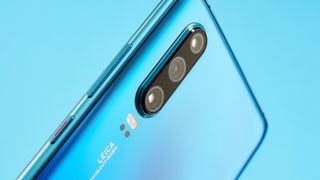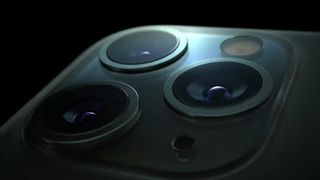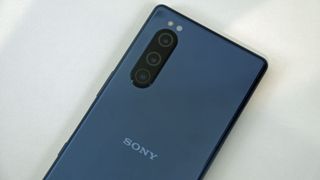Do the new iPhone 11 cameras bring anything new to mobile photography?

It seems that no matter how capable the competition is, everyone is still curious as to what Apple is doing with its latest phones – this year it's the iPhone 11, iPhone 11 Pro and iPhone 11 Pro Max. And that applies to the cameras as much as anything else.
The likes of Huawei, Google, OnePlus and Oppo may have gone to great lengths to push out new combinations of sensor, lens and processing wizardry in their most recent models, and while not all examples have shone as much as they could have, this fierce competition has done much to ramp up the standard that's now expected.

Lenses now reach further into the distance than before, while stabilization is more stable, even at these extended zoom settings, and focus even faster. The promise of AI- and machine-learning-based technologies promise to tweak performance for even greater gain.
No light? No problem – today's top camera phones mop up what's there, work their magic to compensate for what isn't there, and spit out something beyond the level we have any right to expect from a device whose primary purpose isn't to take photos.
So, with plenty going in other corners, do photographers have anything to get excited about with Apple's latest handsets?
New camera system
The standard of smartphone cameras may already be pretty damn good, but the likes of slightly better autofocus, more accurate color, or improved low-light performance don't quite shift units like entirely new features do – features like a whole new lens.
Last year's iPhone XS had a dual-camera setup, one bearing a standard lens and one a telephoto, but we've become used to seeing triple- and quad-camera setups elsewhere, with depth-sensing time-of-flight sensors on hand for even better performance.
While the iPhone 11 – this year's 'entry-level' iPhone – also rocks two cameras on its rear, the iPhone 11 Pro and iPhone 11 Pro Max both sport three, each backed by a 12MP sensor.
Much like zooming further into the distance and still managing to end up with a sharp and detailed result – there's a reason compact cameras with huge zoom lenses are still around while other have vanished – being able to capture images with a wider field of view than you previously could is a genuinely useful for everyday imaging.
With the likes of the Samsung Galaxy S10 and Huawei P30 Pro standing out for their ultra-wide lenses, Apple had to match or better them here. So has it? Well, the 13mm focal length is wider than the P30 Pro's 16mm, and that 3mm can be significant at the wider end of things, much more so than at telephoto distances.
The 120-degree field of view of Apple's 13mm lens is more or less the same as the 123-degree angle of view claimed by Samsung for the 12mm lens on its own S10 models, so it's certainly no deal-breaker.

Still, it's a welcome addition for those traveling, or who frequently shoot group portraits. It's also eminently useful for indoor shots, although the f/2.4 aperture is 'slower' than the f/1.8 aperture on the 26mm main lens, which means you need a faster shutter speed to get shake-free shots – so more focus will be placed on the OIS system and Night mode, and perhaps the AI, to keep images looking crisp.
So what else is new? Well, you could have put your money on a new filter, and we have it in the shape of the High Key Mono option. It looks impressive, but you'll probably forget it's there. The Night mode now springs to life when it reckons its magic is necessary, which is handy, although quite how it differs in performance from before is something we're yet to discover.
Similarly, the benefits of better subject detection through semantic rendering, together with the advantages of the extended dynamic range and next-generation Smart HDR will only be discovered in use. And the forthcoming Deep Fusion mode, which assembles a number of images into one for better details and low noise, may well do a grand job when your subject is relatively static and well lit – but how about when it isn't? Or when it's moving?
Quite what Apple means when it says the iPhone 11 Pro delivers the "highest-quality video ever in a smartphone" is also something that may well be true, but just how Apple has determined this, and whether it's significantly better than whoever it deems to be the runner-up in this particular race, also remains to be seen. But on the more tangible usability side of things – and particularly when you factor in the forthcoming Filmic app – it certainly seems Apple is keen to make the videographer's life a lot easier.
?Do rivals still have the upper hand
Ignoring the lack of 5G and other non-imaging aspects, the new iPhone don't trounce their rivals in every way on paper. The zoom range on the Pro and Pro Max, which have an additional 52mm telephoto lens, is essentially only a 4x optical zoom, for example, even if it does have an arguably more useful wide-angle start. True, rivals that claim to reach to a 10x zoom might not do so optically, but if the quality is good enough, that's less of a concern to the everyday photographer.
Quite how Apple's claims of 100% focus pixels translates to fast focus is something we'll only know once we get to test the cameras fully. But focusing has been in Sony's crosshairs in recent times, and the company has bought its Eye AF technology to its Xperia 1 and more recent Xperia 5 cameras, with deep-learning-based face detection and Eye Stabilizer technology. Sony's autofocusing systems have impressed us on its Cyber-shot and Alpha cameras, so the decision to imbue its Xperia line of smartphones with similar tech may see the company gain more traction here.

Overall, it's great to see Apple focusing on new hardware that should make it easy enough to capture images quite different from what was possible with previous iPhones, while the tweaks to usability to make those captures easier is also very welcome. And, for most people, this is perhaps the perfect partnership: more obvious advantages from things like the new lens combined with a more effortless route to the results they want.
Unlike with the video side of things, where it seems Apple is keen to provide users with more manual control, it seems like the brand is trying to make things easier for stills photographers. Maybe photographers already have all the manual control they need in a high-end iPhone; or maybe there's only so much that makes sense or is practical to include.
The iPhone 11 range may not have a single photographic USP that elevates the cameras above what we've already seen elsewhere, but when everything-else-iPhone is thrown into the mix, it may well be that the average photographer is satisfied enough to forget about any headline features that Apple's rivals might be shouting about.

Comments
Post a Comment